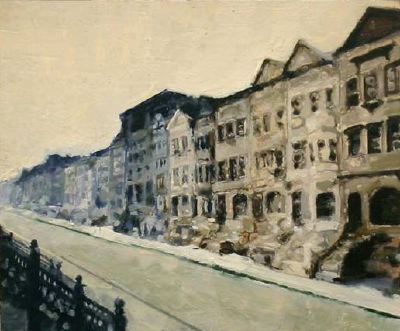Painting from Death: Bodner on creating from photographs
May 15th, 2006
To paint from a photograph is inherently different than painting from life. Some artists avoid photos, others use them, perhaps covertly, for practical reasons. But to American artist Dan Bodner, painting from photos is not merely a technique, but a way to focus on his role as an artist. I interviewed Bodner recently at his studio in Amsterdam.
Question: When you work from photographs, do you ever ask yourself, what is the point of making the painting, when the image already exists in the photo?
Bodner: No. A photo is a record of a moment that has passed, a dead moment. I don’t feel that I own the image as a photograph until I paint it as a painting. The photo itself always refers to the past. But a painting of the photo is a creation, which goes on living. The painting defines its own continuing moment in time.
Question: Does painting go beyond the goal of simply making an image?
Bodner: What painting is for me is part of human desire. Every kid smears his food, or shit, and that is really connected to what painting is. A kid makes a mark and has the satisfaction of knowing “I made this and it will stay there.” For an adult I think it is connected to fear of death, which is innate. And it is connected to the desire to procreate. As you get older it gets existential, of course. To take things out of you and put them into the world, there is an absolute satisfaction in that. To do this from a photo emphasizes the act of creation, bringing life to something dead.
____
In the next post, more about how Dan Bodner uses photos, his subjects and his methods
May 15th, 2006 at 10:28 am
Interesting topic for a post. I’m always surprised by how many paintings depict dead loved ones, and are based on a combination of memory and photographs. Looking forward to the next installment.
May 15th, 2006 at 4:26 pm
The idea and ownership of an image by painting it intrigues me. I think there is a basic human desire to own things and make a mark on them– from a person scratching their initials into a tree to lusting after the girl next door. I think artists use their work to own what either cannot be owned, that which is fleeting, that which doesn’t exist, or that which doesn’t fit into acceptable rules of society.
May 15th, 2006 at 6:01 pm
I think nowadays photographs are an easy available way of helping the images out of our imagination to take shape. When lack of models is a problem, we have to resource to photographs. However, if I am looking for an exotic and intriguing picture of a woman for example I do not go to magazine models or stars but I use myself as a model surrounded by the photograph landscape that I want to portrait. Of course if I was able to travel freely every time and had these looking models available and it would also be a very interesting experience and the outcome would probably be far different. There are no words to express how the living experience can be more relevant to painting than a photograph. Paul Gaugin who has travelled to different countries to pursuit exotic different paintings has once said: “I love Brittany; here I find savage, primitive quality. When my clogs echo on this granite ground, I hear a dull , muted, powerful sound I am looking for in a painting…I live like a peasant and am know as a savage”
Photographs cannot smell or sound or give a whole experience to the inspiring mind of an artist. Paul Gaugin also wrote “Life (in Madagascar) doesn’t cost a thing for a person who wants to live like the natives. Hunting suffices to supply you easily with food. Consequently, if I can close a deal, I am going to…live free and create art (…) out there, having a woman is compulsory, so to speak, which will give me a model every day.”
June 2nd, 2006 at 10:53 pm
we do not see the photograph, we see the artist interpretation of an image. Be it breathing or in a 2 dimension state when created makes no difference when you can capture a definite emotion like Mr Bodner can
I feel blessed to have seen these works Thank you
Canadian artist Amber Lounder